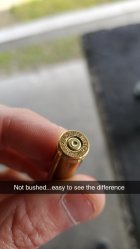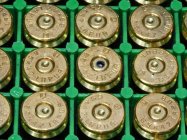With that chamber and 32-inches, your pressures should be fine at 2,790 fps. Top US FTR competitors run their 90s at 2,800 - 2,850 fps from 30-inch barrels, mostly with VarGet for the lower value and H4895 for the higher (at a cost in case-life though!). The one remaining question mark is Starline 223 case capacity. (I bought some recently to give them a try, but have yet to load and fire any, so don't have the fireformed-case 'water overflow capacity' yet to compare to Norma or Lapua 223. Their case weights are however relatively low which usually results in greater internal capacity.)
So, it looks like it may be a primer cup toughness allied to firing pin diameter and its clearance in the bolt face issue. Although Federal says its 205/205M 22.5 thou' thick cups are NATO standard, every other maker uses heavier 25 thou' cups for higher pressure applications. My own limited experience of the F205M is that is much more robust than thin Rem 6 1/2 / CCI-400 models, but not as tough as CCI-450/BR4s and (maybe) the Rem 7 1/2BR. So, before exploring firing pin turning / bolt bushing, I'd at least try one of them with your existing load.
There is a great deal of information about long-range 223 / 90gn FTR loads on the forum. Do a search of '223 90gn FTR' and also of
@Ned Ludd who is a prolific source of good information on this combination on the forum.
Since my throat is .200-.300” longer than the load manual, I can presume than my chamber pressure is lower.
How much lower?
A huge amount! That's why Dave Kiff at PT&G and Manson produce the 223 ISSF and T15 respectively to accommodate 90s seated right out.
As an example of the difference between loads for the 90gn SMK provided by Vihtavuori and Sierra at their short COALs based on CIP and SAAMI standard 223 Rem chambers (25 thou' throat in the latter case) and your throat giving a 2.620-inch COAL, I ran QuickLOAD for Sierra 6th Ed manual's 2.43-inch COAL and H. VarGet in a 30.5 gn water capacity case (what Lapua comes out at with my minimum-SAAMI match chamber) in a 32-inch barrel. And then again at 2.620-inch. (Unlike N150, QuickLOAD's default powder values are pretty good for 223 and heavy bullets, and this is probably the favourite powder for the application anyway on your side of the Atlantic.)
2.43-inch COAL ....................... 23.3gn: 55,243 psi / 2,785 fps
Run that combination in your T15 chamber at 2.620-inch COAL, and the 23.3gn charge is calculated to produce 46,892 psi / 2,703 fps.
Using the pressure reduction produced by the long throat (not to forget the extra room in the case for powder below the bullet, and the charge increases to:
2.62-inch COAL ....................... 24.6gn: 54,770 psi / 2,827 fps
This is of course just a computer model and the usual caveats apply, but I'd reckon the PMax / MV differences won't be far out.
@Ned Ludd may care to comment as he has considerable experience with actual loads and MVs for this powder and 90s in long throated chambers.














